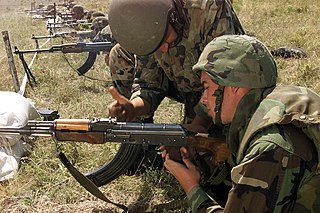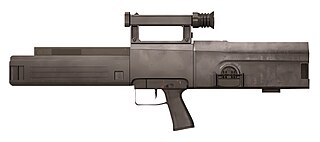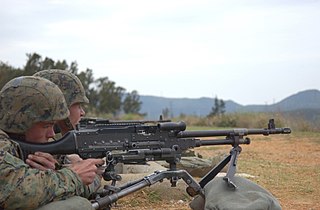Related Research Articles

A squad automatic weapon (SAW), also known as a section automatic weapon or light support weapon (LSW), is a man-portable automatic firearm attached to infantry squads or sections as a source of rapid direct firepower. Weapons fulfilling this role can be light machine guns, or modified selective-fire rifles fitted with a heavier barrel, bipod and a belt/drum-fed design.

The XM29 OICW was a series of prototypes of a new type of assault rifle that fired 20 mm HE airbursting projectiles. The prototypes were developed as part of the Objective Individual Combat Weapon program in the 1990s. The term SABR was also used at certain points, but is less common.

The Objective Individual Combat Weapon or OICW was the next-generation service rifle competition that was under development as part of the United States Army OICW program; the program was eventually discontinued without bringing the weapon out of the prototype phase. The acronym OICW is often used to refer to the entire weapons program.

A light machine gun (LMG) is a light-weight machine gun designed to be operated by a single infantryman, with or without an assistant, as an infantry support weapon. LMGs firing cartridges of the same caliber as the other riflemen of the same combat unit are often referred to as squad automatic weapons.
The M60, officially the Machine Gun, Caliber 7.62 mm, M60, is a family of American general-purpose machine guns firing 7.62×51mm NATO cartridges from a disintegrating belt of M13 links. There are several types of ammunition approved for use in the M60, including ball, tracer, and armor-piercing rounds.

The Heckler & Koch G11 is a non-production prototype assault rifle developed from the late 1960s–1980s by Gesellschaft für Hülsenlose Gewehrsysteme (GSHG), a conglomeration of companies headed by firearm manufacturer Heckler & Koch, Dynamit Nobel, and Hensoldt Wetzlar. The rifle is noted for its use of caseless ammunition.

A magazine, or simply called mag, is an ammunition storage and feeding device for a repeating firearm, either integral within the gun or externally attached. The magazine functions by holding several cartridges within itself and sequentially pushing each one into a position where it may be readily loaded into the barrel chamber by the firearm's moving action. The detachable magazine is sometimes colloquially referred to as a "clip", although this is technically inaccurate since a clip is actually an accessory device used to help load ammunition into a magazine or cylinder.
The Special Purpose Individual Weapon (SPIW) was a long-running United States Army program to develop, in part, a workable flechette-firing "rifle", though other concepts were also involved. The concepts continued to be tested under the Future Rifle Program and again in the 1980s under the Advanced Combat Rifle program, but neither program resulted in a system useful enough to warrant replacing the M16.

A medium machine gun (MMG), in modern terms, usually refers to a belt-fed machine gun firing a full-powered rifle cartridge, and is considered "medium" in weight. Medium machine guns are light enough to be infantry-portable, but still cumbersome enough to require a crew for optimal operational efficiency.
The Advanced Combat Rifle (ACR) was a United States Army program, started in 1986, to find a replacement for the M16 assault rifle. Under the stress of battle the average soldier with an M16 may shoot a target at 45 meters, but hit probability is reduced to one out of ten shots on target by 220 meters. Because of this, the ACR program was initiated in the late 1980s to create a weapon that could double the hit probability. The ACR program was preceded by older programs such as the Special Purpose Individual Weapon. The program ended in 1990 after an expenditure of approximately US$300 million.
The Advanced Individual Combat Weapon (AICW) was an Australian prototype combination assault rifle and grenade launcher developed as a technology demonstrator. The AICW combined a standard 5.56 mm assault rifle based on the successful F88 Austeyr with a superposed load grenade launcher developed by Metal Storm.
Ares Incorporated is an American weapons manufacturer and firearms engineering company co-founded by the American weapons inventor and developer Eugene Stoner in 1971. The company is based in Port Clinton, Ohio, and produces fire control systems, turret systems, small arms, automatic cannons and industrial machinery. Mr. Stoner left the company in 1989, joining Knight's Armament Company in 1990, where his designs included the Stoner 96, a further refinement of the Ares LMG/Stoner 63.
The Lightweight Small Arms Technologies (LSAT) program is funded by the U.S. Joint Service Small Arms Program, with the goal of significantly reducing the weight of small arms and their ammunition. Following a series of military programs to investigate advances in small arms, the LSAT program is the US military's latest project to replace existing US small arms. Tactical concepts and the research from the previous small arms programs indicates that lightening small arms is the first significant step towards increasing soldiers' lethality and survivability.

The LSAT light machine gun is a component of the Lightweight Small Arms Technologies (LSAT) program. The purpose of the program was to develop a lighter, yet highly reliable light machine gun (LMG). The program was initiated in 2004, when the Joint Service Small Arms Program (JSSAP) challenged the American defence industry to develop a lighter small arms and also design lighter ammunition.
LSAT may refer to:

LSAT caseless ammunition is caseless ammunition produced as part of the U.S. Army’s Lightweight Small Arms Technologies (LSAT) program.

The M249 SAW, formally written as Light Machine Gun, 5.56 mm, M249, is the US military’s adaptation of the Belgian FN Minimi, a light machine gun manufactured by FN Herstal (FN).

Telescoped ammunition is an ammunition design in which the projectile is partially or completely enveloped by the propellant. Examples include ammunition for both hand weapons and artillery. Caseless ammunition is often telescoped.

Polymer-cased ammunition (PCA) is firearm ammunition (cartridge) with casings made from synthetic polymer instead of the typical metallic casing. PCA is considered a new alternative that potentially reduces production cost and weight for long guns and handguns.

The Next Generation Squad Weapon (NGSW) program is a United States military program created in 2017 by the U.S. Army to replace the 5.56mm M4 carbine, the M249 SAW light machine gun, and the 7.62mm M240 machine gun, with a common system of 6.8mm cartridges and to develop small arms fire-control systems for the new weapons.
References
- 1 2 3 4 5 6 7 8 9 10 11 12 13 14 15 16 Spiegel, Kori; Paul Shipley (21 May 2008). "Lightweight Small Arms Technologies" (PDF). International Infantry & Joint Services Small Arms Systems Symposium. National Defense Industrial Association. Archived from the original (PDF) on 1 May 2017.
- 1 2 3 Bruce, Robert. "LSAT The Future of Small Arms Now?". American Rifleman . National Rifle Association of America. Archived from the original on 24 January 2009.
- 1 2 "Descriptive Summaries of the Research, Development, Test and Evaluation Army Appropriation, Budget Activities 1, 2 and 3". Office of the Secretary of the Army. February 2007. Archived from the original on 21 April 2009. Retrieved 9 September 2017.
- ↑ Spiegel, Kori; Paul Shipley. "Lightweight Small Arms Technologies" (PDF). Army Science Conference. Archived from the original (PDF) on 24 April 2009. Retrieved 9 November 2008.
- ↑ Textron Systems' Light Armaments Team to Develop Lightweight, Cased-Telescoped Small Arms for U.S. Army Archived 28 October 2017 at the Wayback Machine - Marketwatch.com, 14 May 2014